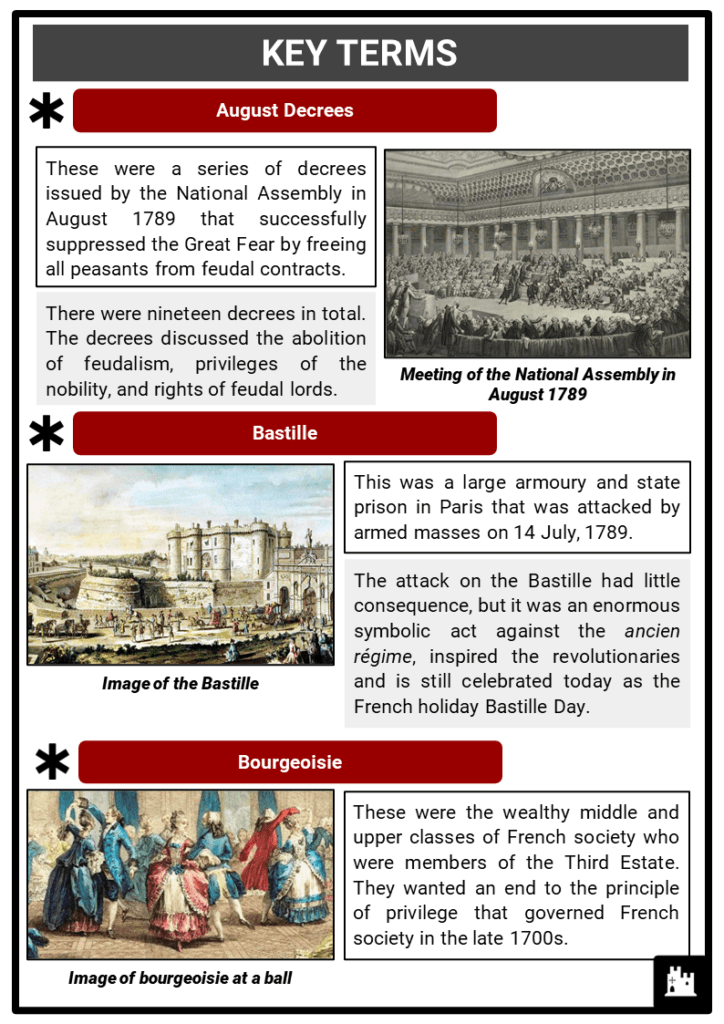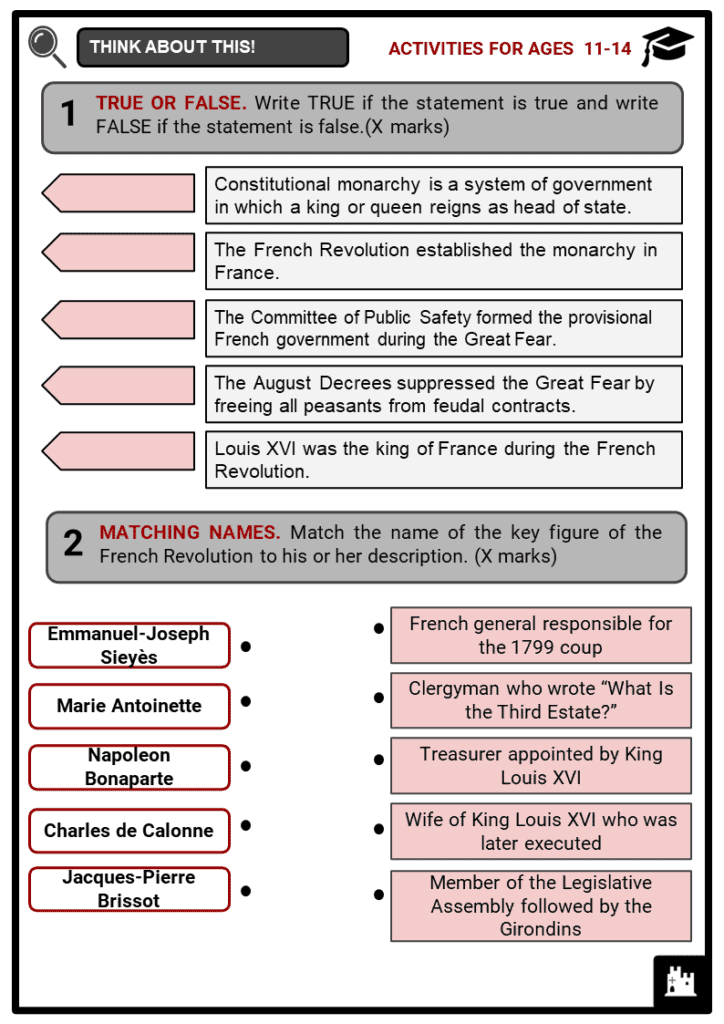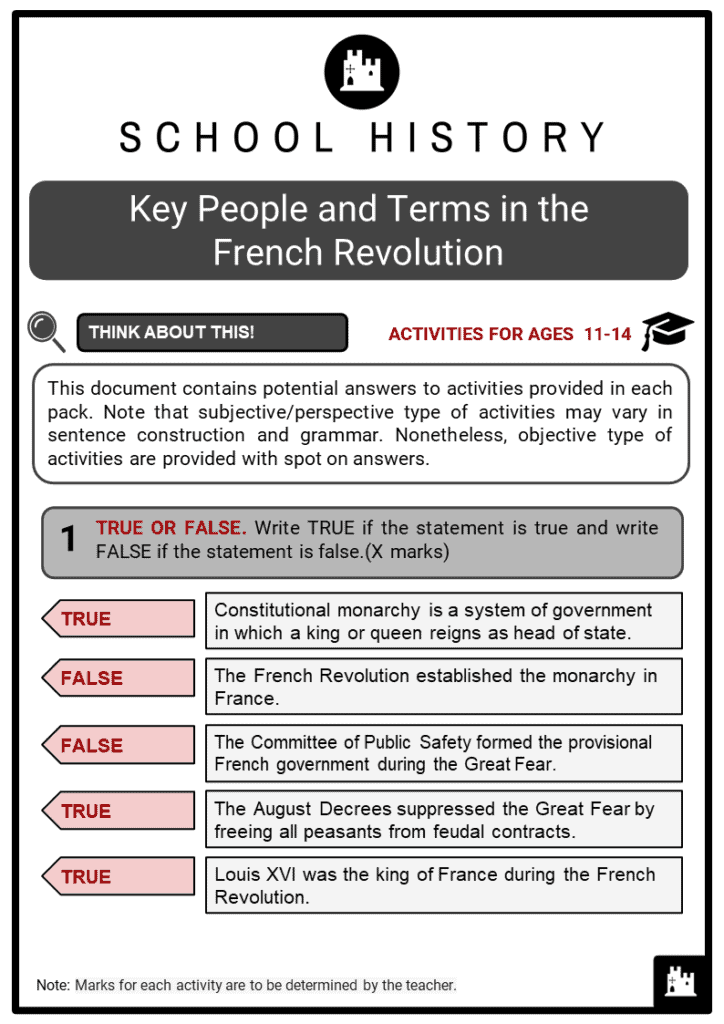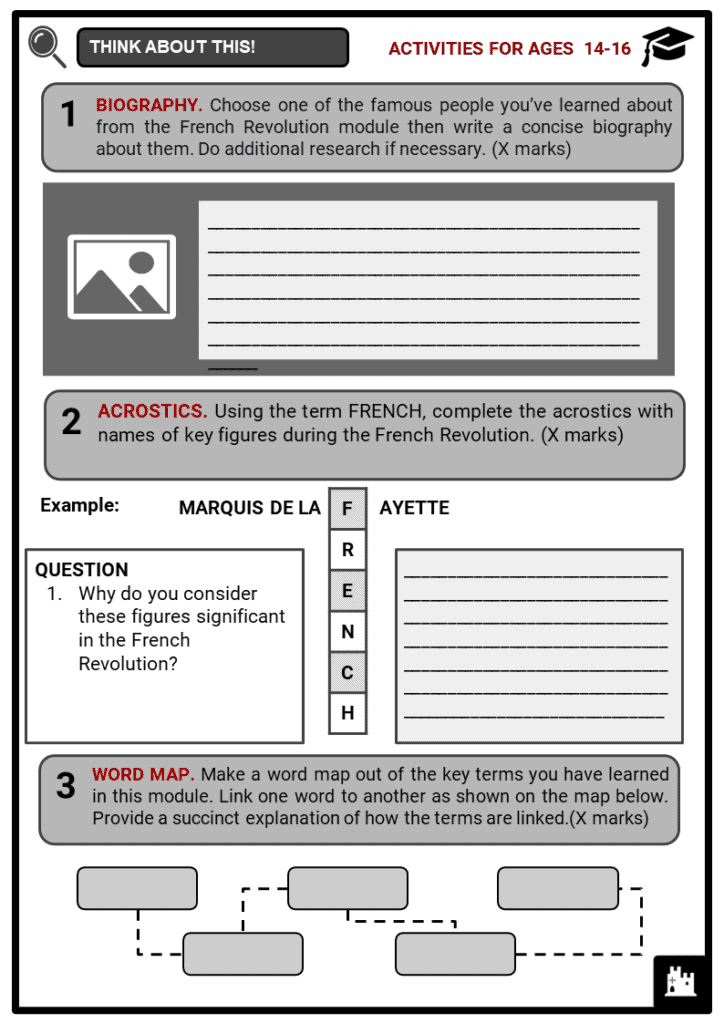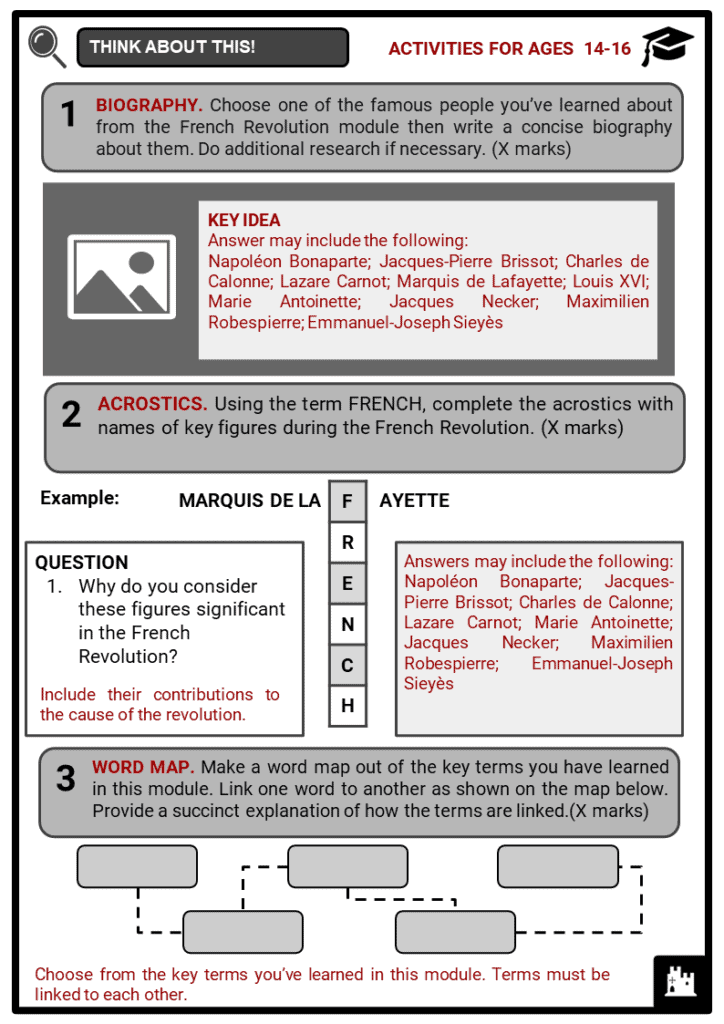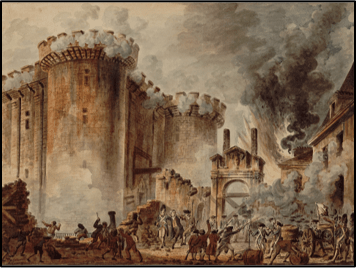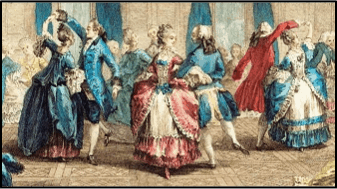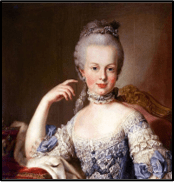Download Key People and Terms in the French Revolution Worksheets
Do you want to save dozens of hours in time? Get your evenings and weekends back? Be able to teach Key People and Terms in the French Revolution to your students?
Our worksheet bundle includes a fact file and printable worksheets and student activities. Perfect for both the classroom and homeschooling!
Summary
- Key terms that refer to significant places, events and names during the French Revolution
- Key people involved in the French Revolution
Key Facts And Information
Let’s know more about Key People and Terms in the French Revolution!
- The French Revolution took place between 1789 and 1799.
- There were some decrees that were facilitated by the National Assembly.
- The French Revolution resulted in key changes in France. For instance, everybody would now pay personal taxes and the monarchy was abolished.
- It was made possible by some key people discussed in this module.
Key Terms
August Decrees
- These were a series of decrees issued by the National Assembly in August 1789 that successfully suppressed the Great Fear by freeing all peasants from feudal contracts.
- There were nineteen decrees in total. The decrees discussed the abolition of feudalism, privileges of the nobility, and rights of feudal lords.
Bastille
- This was a large armoury and state prison in Paris that was attacked by armed masses on 14 July, 1789.
- The attack on the Bastille had little consequence, but it was an enormous symbolic act against the ancien régime, inspired the revolutionaries and is still celebrated today as the French holiday Bastille Day.
Bourgeoisie
- These were the wealthy middle and upper classes of French society who were members of the Third Estate. They wanted an end to the principle of privilege that governed French society in the late 1700s.
- The bourgeoisie represented the moderate voices during the French Revolution and was both the Estates-General and represented by delegates in the National Assembly.
Civil Constitution of the Clergy
- A directive issued by the National Assembly in July 1790 that broke ties with the Catholic Church and established a national church system in France with a process for the election of regional bishops.
- It caused uproar amongst the French Catholics who were now against the revolutionaries.
Committee of Public Safety
- This committee formed the provisional French government during the Reign of Terror.
- Maximilien Robespierre was the chair of this committee to which the National Convention gave dictatorial powers in April 1793 in an attempt to deal with France’s wars abroad and economic problems at home.
Declaration of Pillnitz
- This was a warning issued on 27 August, 1791, by Prussia and Austria announcing that they would bring military intervention if any harm came to King Louis XVI, who had just been captured trying to escape with his family from Paris. Jacques-Pierre Brissot, as a result, declared war on Austria and Prussia.
Girondins
- This was a name given to the moderates in the National Convention. They were in control of the legislative assembly until 1793, when, with the war going poorly and food shortages hurting French peasants, the Jacobins ousted them from power.
Great Fear
- The Great Fear took place during the French Revolution when rural peasants revolted against their feudal landlords and wreaked havoc on the French countryside.
Jacobins
- It contained radical politicians who were representatives in the National Convention. Led by Maximilien Robespierre, they called for democratic solutions to France’s problems and spoke for the French urban poor and peasants.
- The Jacobins took control of the convention and France itself from 1793 to 1794. As Robespierre became increasingly paranoid about counterrevolutionary threats, he instituted a brutal period of public executions known as the Reign of Terror.
Limited Monarchy/Constitutional Monarch
- This can be defined as a system of government in which a king or queen reigns as head of state but with some regulation of his/her powers by a legislature and an independent court system.
National Assembly
- The name was given to the Third Estate after it separated from the Estates-General in 1789. It claimed to legitimately represent the French population. The assembly dissolved in 1791 so that new elections could take place under the new Constitution.
National Convention
- It replaced the National Assembly following a successful election in 1792.
- As one of its first actions, the convention declared the French monarchy abolished on 21 September, 1792, and on the following day declared France a republic.
Reign of Terror
- A ten-month period of oppression and execution from late 1793 to mid-1794 led by Maximilien Robespierre and the Committee of Public Safety to suppress any potential enemies of the radical Revolution.
- The Reign of Terror ended with the fall of Robespierre, who was arrested and executed in July 1794.
Thermidorian Reaction
- This occurred after the Reign of Terror period and happened after the execution of Maximilien Robespierre in July 1794 and the reassertion of moderate power over the French Revolution.
- The Thermidorian Reaction helped in getting the French Revolution back on track.
Third Estate
- One of the three estates in the Estates-General that had the commoners of France, whether rich merchants or poor peasants, as members. Although it constituted the vast majority of the French population, it had just one vote in the Estates-General, the same vote that the much smaller First Estate (clergy) and Second Estate (nobility) each had.
- Frustrated with its political incapability, the Third Estate broke from the Estates-General on 17 June, 1789, and declared itself the National Assembly.
Versailles
- The royal palace built by King Louis XIV a few miles outside of Paris. Known for its extraordinary splendour, extravagance and immense size, Versailles was the home of the king, queen and all members of the royal family, along with high government officials and select nobles.
- On 5 October, 1789, a mob of angry and hungry French women marched on Versailles, bringing the royal family back to Paris to deal with the food shortage.
Key People
Napoleon Bonaparte
- He was a general in the French army and was responsible for the 1799 coup that overthrew the Directory. Napoleon’s rise marked the end of the French Revolution and the beginning of Napoleonic France and Europe.
Jacques-Pierre Brissot
- He was a member of the Legislative Assembly and National Convention who was politically neutral but believed in the idea of a constitutional monarchy.
- Brissot’s followers, initially known simply as Brissotins, eventually became known more generally as the Girondins. He unsuccessfully declared war on Austria and Prussia.
- His unsuccessful declaration of war caused his removal from the National Convention and, like many Girondin leaders, he lost his life at the guillotine during the Reign of Terror in 1793–1794.
Charles de Calonne
- He was like the treasurer to the monarch. He was appointed by King Louis XVI after Jacques Necker was forced out of office in 1781.
- He came up with the idea of imposing more taxes on the wealthy rather than the poor, suggesting a tax on land proportional to land values and a lessened tax burden for peasants. The French nobles rejected his plan.
Lazare Carnot
- A French soldier appointed by the Committee of Public Safety to help reorganise the failing war effort against Austria and Prussia. He carried out a tremendous job and earned himself a seat as one of the first members of the Directory.
- He was removed later on during the coup on 4 September, 1797. He went on to hold various posts in future governments.
Marquis de Lafayette
- He was a liberal nobleman who led French forces in partaking in the American Revolution.
- Commoners in France revered Lafayette as an idealistic man who was dedicated to liberty and the principles of the Revolution. Although Lafayette organised the National Guard of armed citizens to protect the Revolution from attack by the king, he balked as the Revolution became more radical.
Louis XVI
- Louis XVI was the French king from 1774 to 1792 but was done away with during the French Revolution and later executed in 1793.
- He had inherited the debt problem left by his grandfather, Louis XV, and added to the crisis himself through heavy spending during France’s involvement in the American Revolution between 1775 and 1783.
- He was overwhelmed with his massive debt and was forced to give in to the demands of the Parliament of Paris and convene the Estates-General.
Marie-Antoinette
- She was the wife of King Louis XVI and, in the French commoners’ eyes, the epitome of the French royalty’s extravagance and excess. She was executed in 1793 just as her husband was.
Jacques Necker
- A Swiss-born banker who served as France’s director general of finance in the late 1770s. He was tasked with instituting reforms.
- He was only able to eliminate some costly inefficiencies. He did produce a government budget, however, for the first time in French history.
Maximilien Robespierre
- He was renowned for his brilliance as a political tactician and was the leader of the radical Jacobins in the National Assembly. He wanted to wage war on Austria-Prussia as he was chairman of the Committee of Public Safety.
- He attempted to silence all enemies of the Revolution in an effort to save France from invasion. He was executed on 28 July, 1794, after the moderates regained power and the Thermidorian Reaction got underway.
Emmanuel-Joseph Sieyès
- Author of the fiery What Is the Third Estate?, he was a liberal member of the clergy and supporter of the Third Estate. Made an effort to change the political and economic scene in France.
Image sources:


